


Project Peale: A Guerrilla Landscape Art Project
by anonymous geographers
Artist's Statement
In many places in rural America we find, if we look, evidence that suggests that these places once had very different meanings and values to the humans who encountered them. If we look carefully, we can see 'ghost towns,' places that now seem derelict and abandoned, but with remains of human structures that suggest that these places were once highly valued and intensively used. Rural Pennsylvania is full of ghost towns, places that over 1000 years ago, 200 years ago, or as recently as 20 years ago, were used for settlements, for farming, for lumbering, for mining, or for manufacturing. But today, to look at the surface of these places would be to suggest that they are dead, abandoned: whatever was once viable there has been used up. Peale, Pennsylvania is such a place, a community once built to accommodate the people employed to mine the local seams of coal, but abandoned when mining there was no longer considered economical.
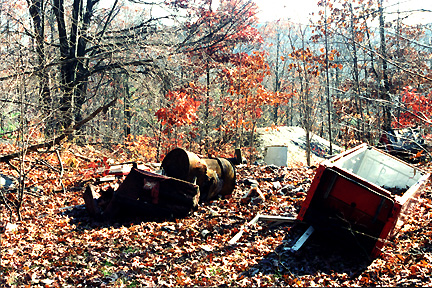
Contemporary relics near Peale.
But ghost towns such as Peale once had life and vitality. They were homes to many people, who lived and worked, were born and died in these real places, with real names, stories, histories, happenings. The evidence in the landscape may be blurred by human destruction or natural processes of revegetation or erosion, but the evidence is there to be discovered. This evidence may be the traces of streets or railroad grades. It may be the foundations of houses, hotels, schools, or factories. Or it may be the overgrown cemetery with toppled and unreadable tombstones.
Evidence of past human settlement can also be seen in the continued growth of domesticated vegetation, once planted in yards and orchards. Apple trees, strawberry plants, a field of Lily-of the Valley - exotic plants 'in the wild' - can serve as evidence that humans had once been in a place and cared enough about that place to tend a garden for themselves and their families.
The evidence of peal shows in road traces, foundations, and especially these domestic garden plants. While walking through the woods and shrubs that have overgrown Peale, you suddenly realize that you are looking at a yucca plant, a lilac bush, and ornamental pine, a catalpa tree - plants that would never be found in the natural ecology of the woodlands of central Pennsylvania.
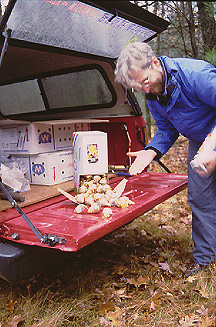
$400 in King Alfred daffodils getting ready for Peale, fall 1995.
It was these discoveries of vegetative traces of past and abandoned human settlements that inspired this commemorative art project. The project was also inspired by commemorative public art and reclamation artworks that have been created over the past twenty years in the American landscape. After reading about project created by artists to reclaim landscapes that had been damaged by human activities such as strip mines and landfills, we set out to explore some of those landscapes and to see what success the artists had in reclaiming and commemorating those spaces. Our explorations led us to wonder how we could create art that would commemorate the town of Peale, to reclaim its lost history, to reaffirm that it had once been a vital place with living people.
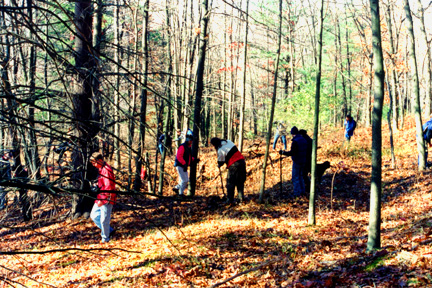
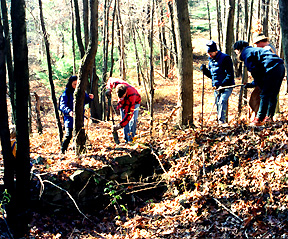
Digging in, fall 1985.
Our solution was to draw on the idea of living evidence of the past: the serendipitous finding of domestic flowers and plants in 'wild settings.' We decided to plant bulbs of domesticated garden flowers, daffodils, around the foundations of some of the former buildings in Peale. This living artwork will show itself, once a year in the early spring, as neat rows of bright yellow flowers marking out the homes, offices, and the hotel that once stood in Peale.
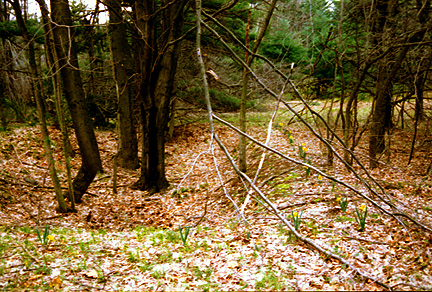
Spring 1996 blooming foundation outlines.
The plants are hardy landscape daffodils that should bloom for many years to come. In the spring, unsuspecting visitors to this presumedly wild place will come upon unusually ordered lines of domestic flowers. If they care to look more closely, perhaps they will see the neat piles of field stones around unusual depressions in the landscape. Perhaps their curiosity will be piques to ask what these flowers, stones, and depressions might mean. Thus Peale, this once-valued place, will come alive again each spring.
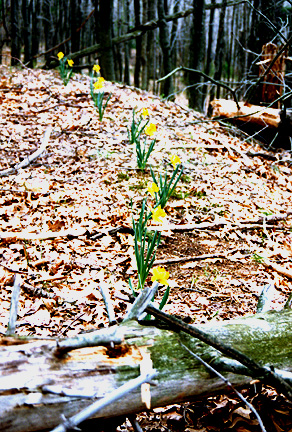
Spring 1996 blooming foundation outlines.
Postscript: Sources have reported that some of the Peale daffodils have been dug up by large, bipedal mammals. Peale was visited in the spring of 1997, 98, and 99 and some daffodils have survived. Our hope is that the word about Peale spreads around and those who have been "borrowing" the daffodils from Peale will return them to Peale. Our hope is also that new flowers will be planted by those who care about Peale and its future.
 These pages comprise an ongoing project to document,
map, interpret, and memorialize the ghost company town of Peale
Pennsyvania located along the Clearfield and Centre County (PA) boundaries in
north-central Pennsyvlania.
These pages comprise an ongoing project to document,
map, interpret, and memorialize the ghost company town of Peale
Pennsyvania located along the Clearfield and Centre County (PA) boundaries in
north-central Pennsyvlania.
Please contact j.b. krygier (jbkrygie@cc.owu.edu) with comments, input, or additional information.
Contents...
Introduction: The Ghost Company Town of Peale, Pennsylvania
Interpreting the Geographies of Peale
The Beech Creek Railroad in the Peale, Pennsylvania Area
Peale Pennsylvania Manuscript Census
>>>Project Peale: A Guerrilla Art Project
Historical Information about Peale and the Tunnel Mines
Kyle Crichton: Peale's Most Famous Son?
Directions to Peale, Pennsylvania
E-mail: jbkrygie@cc.owu.edu